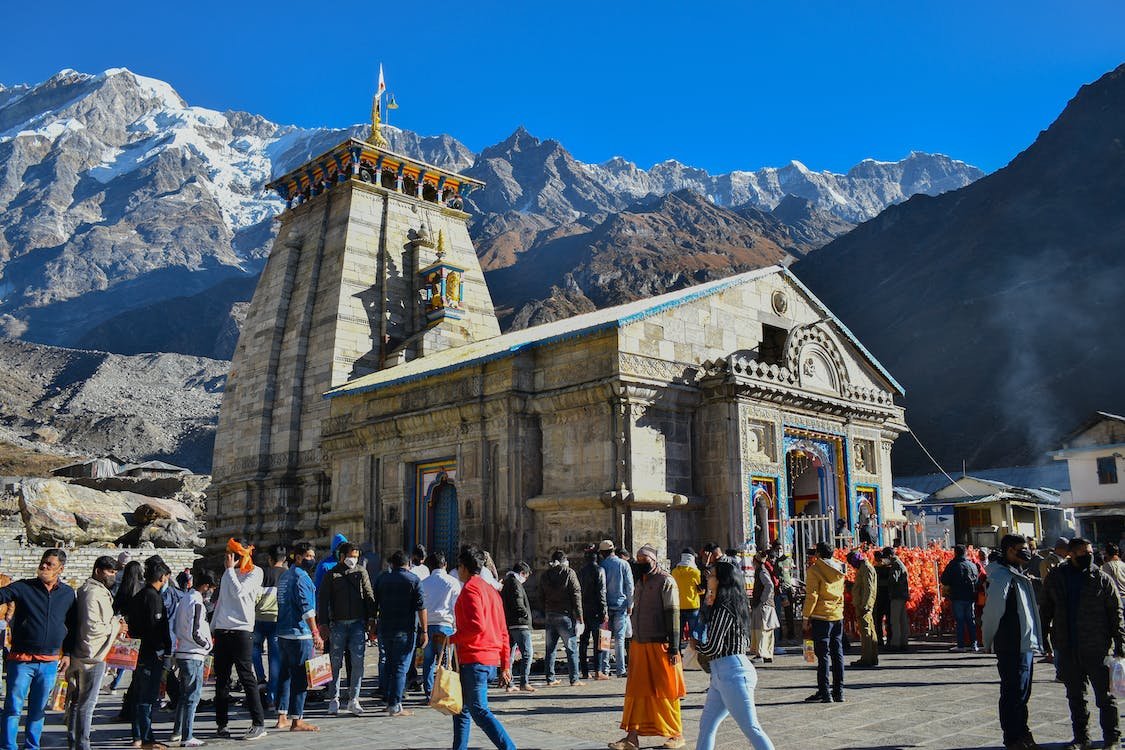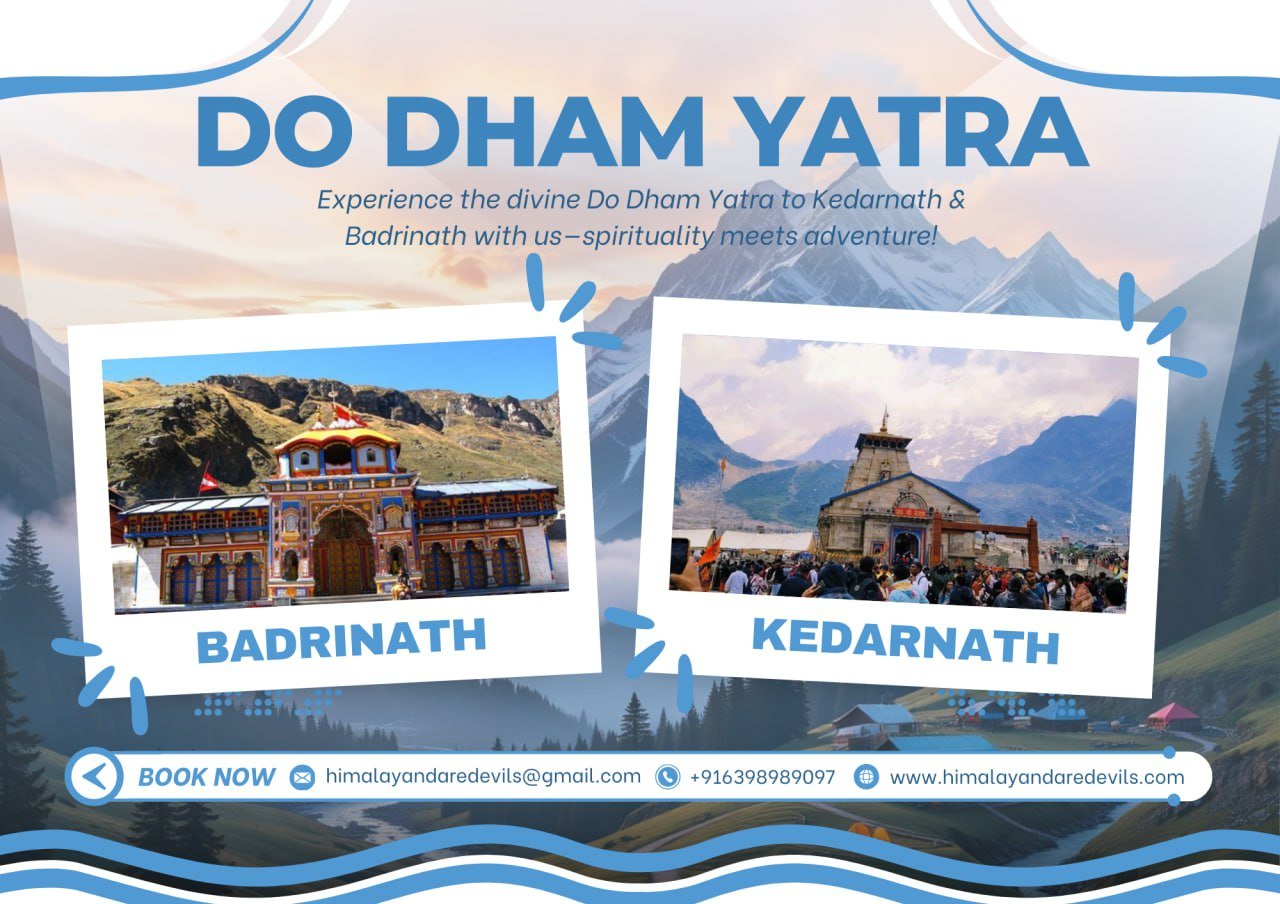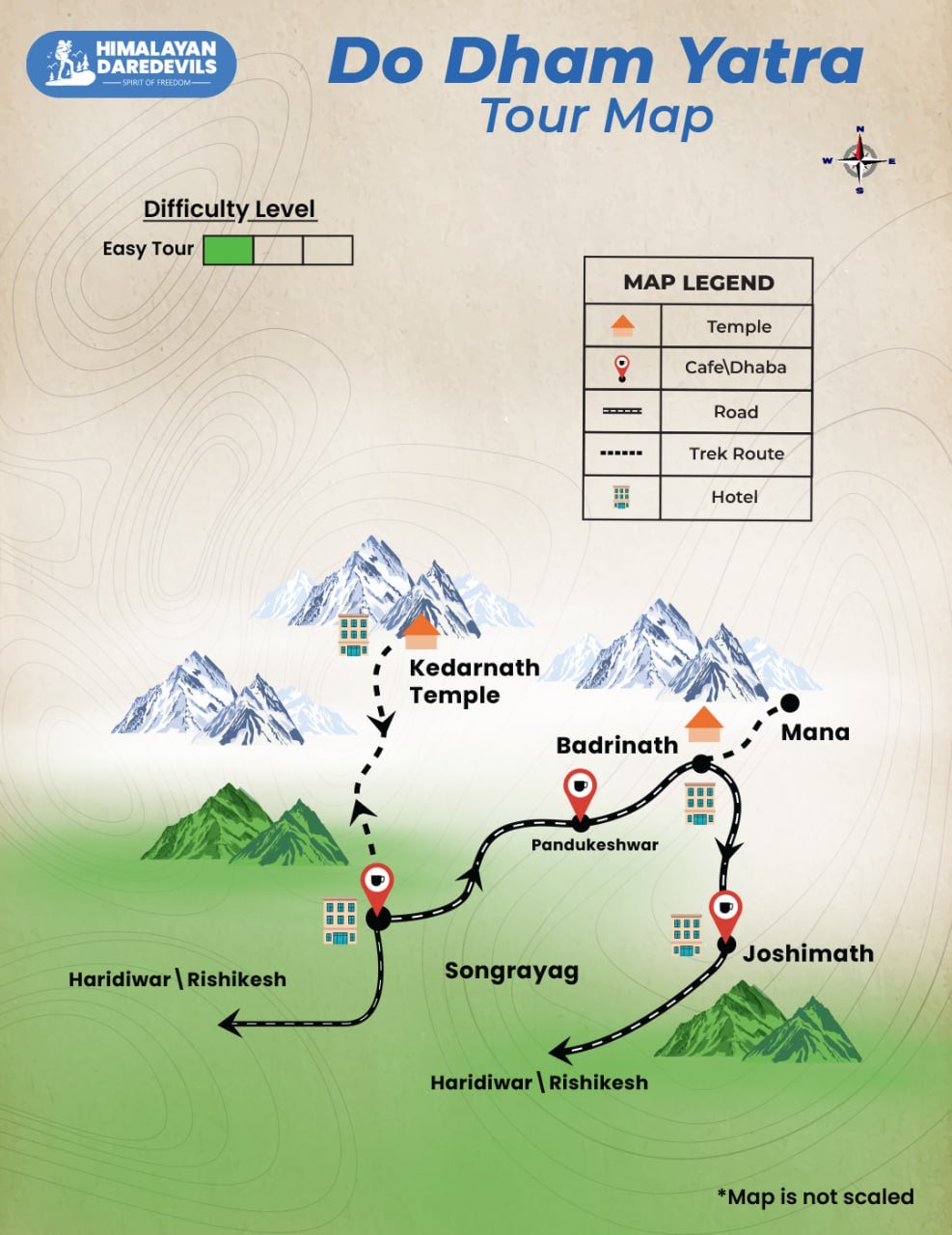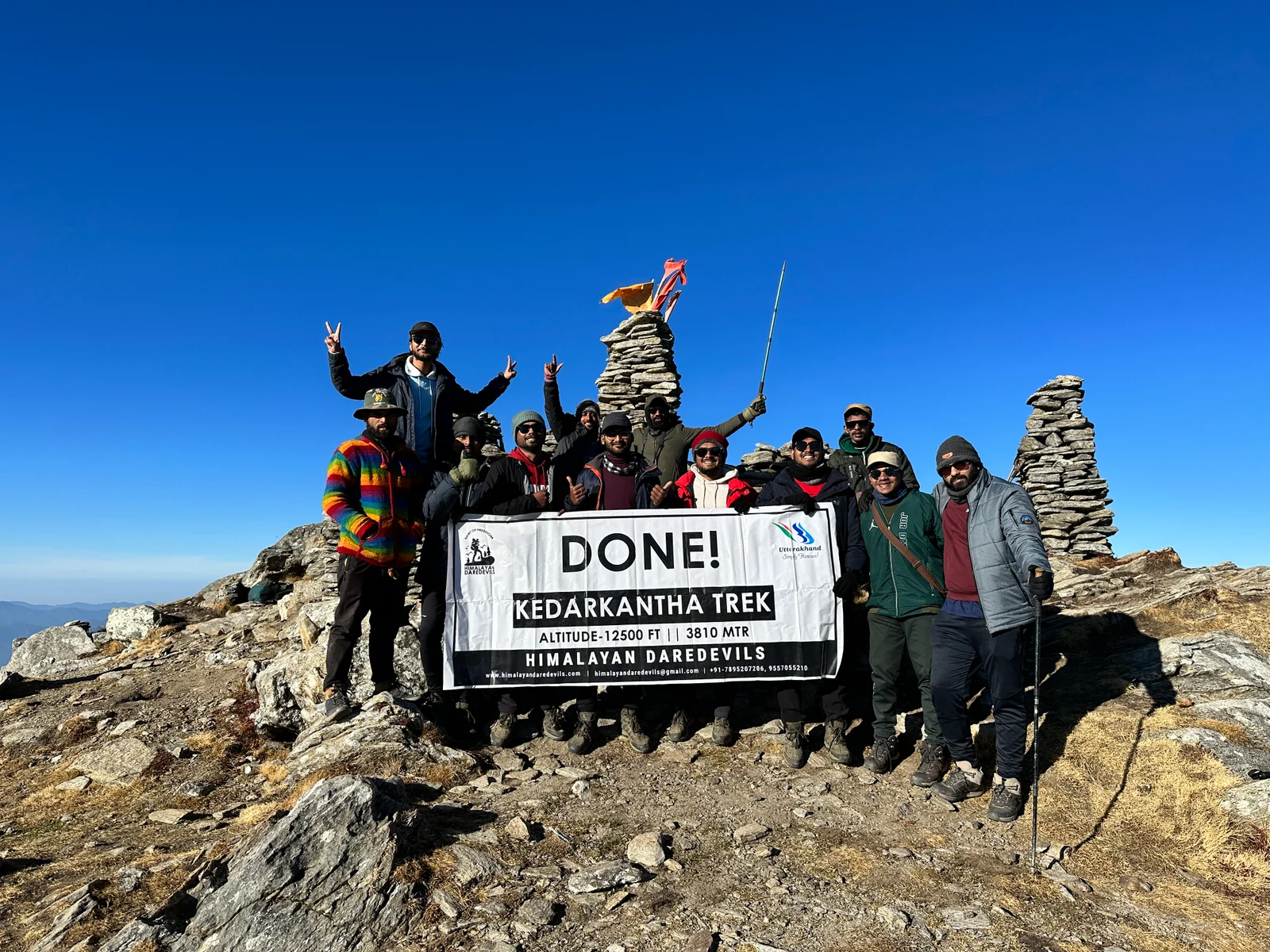Starting From
18,400
16,000.00

Starting From
18,400
16,000.00

Starting From
18,400
16,000.00
Do Dham Yatra - Kedarnath and Badrinath (237+ Reviews)
Pilgrimage Yatra
Haridwar Railway Station
Jolly Grant Airport
Haridwar
May to November
Haridwar to Haridwar
Veg
Hotel / Camp
Uttarakhand
5 Days
Easy
11750 Ft
32 Km
Overview
The Do Dham Yatra typically refers to a pilgrimage tour in the Indian state of Uttarakhand, where devotees visit two of the most revered Hindu temples, Kedarnath and Badrinath. Here’s an overview of the Do Dham Yatra to Kedarnath and Badrinath.
Kedarnath Temple:
- Located in the Garhwal Himalayan range, Kedarnath Temple is dedicated to Lord Shiva.
- It is one of the twelve Jyotirlingas and is believed to be built by the Pandavas.
- The temple is situated at an altitude of 3,583 meters (11,755 feet) above sea level, amidst stunning mountain landscapes.
- Devotees undertake a trek of approximately 16 kilometers from Gaurikund to reach the temple. However, there are also options for helicopter services for those who are unable to trek.
- The temple opens for a limited period each year due to extreme weather conditions in the region.
Badrinath Temple:
- Badrinath Temple is located in the Chamoli district of Uttarakhand, dedicated to Lord Vishnu.
- It is one of the Char Dham pilgrimage sites and is situated along the banks of the Alaknanda River.
- The temple is believed to have been established by Adi Shankaracharya in the 9th century AD.
- Badrinath Temple is situated at an altitude of 3,133 meters (10,279 feet) above sea level, surrounded by snow-capped peaks.
- Devotees can reach the temple by road from Joshimath, which is well-connected by road and is around 45 kilometers away.
Overview of DO Dham Yatra:
- The Do Dham Yatra to Kedarnath and Badrinath is considered highly auspicious among Hindus, particularly for those seeking spiritual rejuvenation.
- It usually takes several days to complete the yatra, including travel time and darshan (worship) at both temples.
- The journey involves traveling through scenic mountainous terrain, offering breathtaking views of the Himalayas.
- Pilgrims often engage in rituals such as offering prayers, performing puja, and taking dips in the holy waters of rivers and hot springs along the way.
- Accommodation facilities are available in nearby towns and villages to accommodate pilgrims during their journey.
Overall, the Do Dham Yatra to Kedarnath and Badrinath offers devotees a profound spiritual experience amidst the natural beauty of the Himalayas.
The altitude and the level of the journey for the Do Dham Yatra to Kedarnath and Badrinath can vary depending on the route taken and the starting point of the pilgrimage. Here’s an overview:
Altitude:
- Kedarnath Temple: Situated at an altitude of approximately 3,583 meters (11,755 feet) above sea level.
- Badrinath Temple: Situated at an altitude of approximately 3,133 meters (10,279 feet) above sea level.
Itinerary
- The journey from Haridwar or Rishikesh to Sonprayag typically begins early in the morning around 6:30 am.
The route initially follows National Highway 58 (NH 58), which runs along the Ganges River, offering beautiful views of the river and the surrounding hills. - As you proceed towards Sonprayag, you’ll pass through picturesque towns and villages nestled amidst the mountains.
The road gradually ascends as you enter the Garhwal Himalayas, and you’ll start witnessing stunning vistas of the snow-capped peaks. - En route, you may have brief stops at scenic viewpoints or roadside eateries to refresh and enjoy the views.
- The journey usually takes around 8-10 hours, depending on road conditions and traffic.
- Upon reaching Sonprayag, trekkers will check into their respective hotels or accommodations.
- Sonprayag serves as the base camp for the trek to Kedarnath, located around 5 kilometers from Gaurikund.
- The village is situated at the confluence of the Mandakini and Basuki rivers, surrounded by lush greenery and towering peaks.
- After check-in, trekkers can relax and unwind, enjoying the tranquility of the Himalayan surroundings.
- Depending on the time of arrival, trekkers may explore nearby areas or take a leisurely stroll around Sonprayag to soak in the natural beauty.
Our Teams will pick up trekkers at Haridwar or Rishikesh morning 6:30 am and then they will be taken to Sonprayag. Check in to respective hotels and rest for the night.
The route from Haridwar or Rishikesh to Sonprayag offers mesmerizing views of the Himalayan landscapes and passes through scenic valleys, rivers, and small towns. Here’s a brief overview of the route:
Haridwar or Rishikesh to Sonprayag:
Sonprayag Check-in:
- The trek from Sonprayag to Kedarnath Temple covers a distance of approximately 16 kilometers.
- The trail follows a well-marked path that ascends gradually through the picturesque Mandakini Valley.
- Trekkers start from Sonprayag and proceed towards Gaurikund, which serves as the base camp for the Kedarnath trek.
- From Gaurikund, the trail continues along the Mandakini River, passing through lush forests, rocky terrain, and scenic meadows.
- Along the way, trekkers will encounter various landmarks such as Rambara, where they can take a short break and refresh themselves.
- The final stretch of the trek involves a steep ascent to reach Kedarnath Temple, situated at an altitude of approximately 3,583 meters (11,755 feet) above sea level.
- The trek from Sonprayag to Kedarnath Temple is considered moderately challenging.
- While the distance is not excessively long, the altitude gain and terrain can make it physically demanding for some trekkers.
- The trail includes both uphill and downhill sections, with some steep ascents and descents.
- Trekkers should be prepared for varying weather conditions, including cold temperatures and occasional rainfall, especially during monsoon season.
- It’s essential to maintain a steady pace, stay hydrated, and take regular breaks to avoid fatigue and altitude sickness.
- Trekkers with a moderate level of fitness and prior trekking experience should be able to complete the trek comfortably with proper preparation and acclimatization.
- Upon reaching Kedarnath, trekkers can choose to stay overnight in camps or hotels available near the temple premises.
- There are several accommodation options ranging from basic guesthouses to more comfortable hotels and tents.
- Staying overnight allows trekkers to rest and rejuvenate before visiting the sacred Kedarnath Temple the next morning.
- The accommodation facilities provide basic amenities such as bedding, meals, and hot water for bathing.
- Trekkers can enjoy the tranquil surroundings and the awe-inspiring views of the Himalayas while staying overnight at Kedarnath.
Route:
Trek Level:
Overnight Stay:
- Start the day by attending the morning “Aarti” (ritual prayers) at the Kedarnath Temple.
- The morning Aarti is a sacred ritual where devotees gather to offer prayers and seek blessings from Lord Shiva.
- It’s a spiritually uplifting experience that sets a positive tone for the day ahead.
- After the morning Aarti, trekkers will begin their return journey from Kedarnath to Sonprayag.
- The trek retraces the same route taken during the ascent, covering a distance of approximately 16 kilometers.
- Trekkers will descend from Kedarnath Temple through the picturesque Mandakini Valley, passing by landmarks such as Rambara and Gaurikund.
- The trail offers stunning views of the surrounding Himalayan peaks, including the majestic Kedarnath Peak.
- Along the way, trekkers can take breaks, enjoy the natural beauty, and capture memorable moments.
- It’s essential to pace oneself and descend carefully to avoid any injuries, especially on steep sections of the trail.
- The descent usually takes around 6-7 hours, depending on individual walking speed and trail conditions.
- One of the best points near Kedarnath Temple for a panoramic view of the surroundings is the Bhairav Temple.
- The Bhairav Temple is located a short distance from Kedarnath Temple, offering stunning vistas of the Kedarnath Valley and surrounding peaks.
- From here, trekkers can admire the beauty of the rugged terrain, the snow-capped mountains, and the flowing Mandakini River.
- The Bhairav Temple itself holds significance in Hindu mythology and is dedicated to Lord Bhairav, a fierce manifestation of Lord Shiva.
- Visitors can spend some time at the Bhairav Temple, soaking in the tranquility of the surroundings and capturing breathtaking views of the Himalayas.
Morning Aarti:
Trek from Kedarnath to Sonprayag:
Best Point near Kedarnath Temple for View:
- After completing the trek from Kedarnath to Sonprayag, trekkers will regroup and prepare for the next leg of the journey.
- Teams will board vehicles for a scenic drive from Sonprayag to Rudraprayag.
- The route passes through picturesque landscapes, winding mountain roads, and charming villages.
- En route, trekkers will have the opportunity to visit Pandukeshwar, a small village known for its historical significance and ancient temple dedicated to Lord Yogadhyan Badri.
- Pandukeshwar is believed to be the place where the Pandavas meditated after the Kurukshetra war.
- Visitors can explore the temple complex, admire the architecture, and soak in the spiritual ambiance.
- From Pandukeshwar, the journey continues towards Badrinath, one of the holiest Hindu pilgrimage sites.
- Badrinath is home to the famous Badrinath Temple dedicated to Lord Vishnu, situated amidst the majestic Himalayas.
- Upon reaching Badrinath, trekkers will check into their hotel accommodation and rest for the night.
- Overnight stay in Badrinath offers the opportunity to relax, enjoy the serene surroundings, and prepare for the darshan (worship) at Badrinath Temple the next day.
Drive from Sonprayag to Rudraprayag via Pandukeshwar and Badrinath
Note: The drive from Sonprayag to Rudraprayag via Pandukeshwar and Badrinath offers breathtaking views of the Himalayan peaks, river valleys, and lush forests. It’s advisable to start early in the day to make the most of the journey and ensure a comfortable arrival in Badrinath. Additionally, trekkers should carry essentials such as water, snacks, and warm clothing for the drive, as the weather conditions in the mountainous region can vary.
After an early morning darshan and breakfast, begin the return journey to Haridwar, concluding your Do Dham Yatra with blessings and unforgettable memories.
Do Dham Yatra - Kedarnath and Badrinath Map

Inclusions
Exclusions
Transport from Haridwar to Haridwar Tempo Traveller or Mini Bus (Non Ac)
Accommodation in Hotel on twin/three/quad share basis all Chardham yatra
Breakfast and Dinner
Good Experience ChardhamYatraTrek Leader Guide
Medical Kit
Personal Insurance
Helicopter Tickets as per Actual (Govt .Rates Applicable )
Personal porters and Mule during the Yatra
Unscheduled or extended stay due to road blocks Landslides
Transport from Haridwar to Haridwar Tempo Traveller or Mini Bus (Non Ac)
Accommodation in Hotel on twin/three/quad share basis all Chardham yatra
Breakfast and Dinner
Good Experience ChardhamYatraTrek Leader Guide
Medical Kit
Personal Insurance
Helicopter Tickets as per Actual (Govt .Rates Applicable )
Personal porters and Mule during the Yatra
Unscheduled or extended stay due to road blocks Landslides
What to carry
- Trekking shoes: A good pair of trekking shoes is essential for a comfortable and safe trek. Look for shoes that are sturdy, provide good ankle support, and have a good grip on different types of terrain.
- Backpack with rain cover (50-60 ltr): A backpack is necessary to carry all your gear. Make sure it's the right size for your trek, and comes with a rain cover to keep your belongings dry in case of rain.
- Thermals (upper and lower): Thermals are lightweight and comfortable base layers that help regulate your body temperature in cold weather. Bring both upper and lower thermals to keep warm.
- 3 T-shirts (advisable quick dry): Choose quick-drying T-shirts made from breathable and moisture-wicking materials. This will help keep you cool and dry during your trek.
- 2 trek pants: Choose lightweight and comfortable trek pants that are easy to move in and can dry quickly if wet.
- Jacket (-10 degrees): A warm jacket is essential for cold weather. Choose a jacket that is waterproof and windproof, and provides good insulation.
- Fleece or hood (2): Fleece jackets or hoodies are great mid-layer options to keep warm. Bring at least two, as they can also be used as an extra layer at night.
- Sunglasses (UV protected): Protect your eyes from the sun's harmful UV rays with sunglasses that are designed for outdoor activities.
- Sun cap: A sun cap or hat with a brim will protect your face and neck from the sun.
- Hand gloves: Bring a pair of lightweight gloves to keep your hands warm and protected from wind and sunburn.
- Woolen cap: A woolen cap will keep your head and ears warm at night or in cold weather.
- Socks (3 pairs min): Bring at least three pairs of good quality socks that are moisture-wicking and provide good cushioning and support for your feet.
- Headlamp: A headlamp will come in handy if you're hiking in low-light conditions or need to find your way in the dark.
- Trekking pole (if needed): Trekking poles can help reduce strain on your legs and provide additional support on steep terrain.
- Rain cover\poncho: A rain cover or poncho will keep you and your gear dry during unexpected rain showers.
- Day pack (if you plan to offload your bag): If you plan to offload your backpack during the trek, bring a smaller day pack to carry essentials like water, snacks, and a first aid kit.
- A toiletry kit: Bring a small kit with personal hygiene items, such as a toothbrush and toothpaste, wet wipes, hand sanitizer, and toilet paper.
- Lunchbox, cup, spoon: If you plan to bring your own food, bring a lunchbox, cup, and spoon to carry and eat your meals.
- 2 one-liter bottles: Staying hydrated is crucial, so bring at least two one-liter bottles to carry water.
- 2-3 plastic covers to keep your wet or used clothes: Plastic bags are useful for keeping wet or dirty clothes separate from the rest of your belongings. They can also be used to pack out any trash or waste you generate during the trek.
How to reach
Haridwar and Rishikesh are two common starting points for the Do Dham Yatra to Kedarnath and Badrinath, both of which are well-connected by road, rail, and air. Here’s how you can reach Haridwar or Rishikesh:
By Air:
- The nearest airport to Haridwar is the Jolly Grant Airport in Dehradun, which is approximately 35 kilometers away. From the airport, you can hire a taxi or take a bus to reach Haridwar or Rishikesh.
- Alternatively, you can also fly to Delhi, which is well-connected to major cities in India and abroad. From Delhi, you can take a connecting flight to Dehradun or take a train or bus to Haridwar or Rishikesh.
By Train:
- Haridwar and Rishikesh are both well-connected by train to major cities in India. Haridwar Junction and Rishikesh Railway Station are the two main railway stations in the region.
- Several trains operate to Haridwar and Rishikesh from cities like Delhi, Mumbai, Kolkata, Chennai, and others.
- Once you reach Haridwar or Rishikesh by train, you can hire a taxi or take a bus to proceed further on your Do Dham Yatra.
By Road:
- Haridwar and Rishikesh are well-connected by road to major cities in North India.
- National Highway 58 connects Delhi to Haridwar via Meerut and Roorkee, while Rishikesh is just a few kilometers away from Haridwar.
- State-run buses, as well as private buses, operate regularly between Haridwar, Rishikesh, and other nearby towns and cities.
- You can also opt to drive to Haridwar or Rishikesh from nearby cities like Delhi, Dehradun, or Chandigarh.
Fitness and preparation guide for Do Dham Yatra - Kedarnath and Badrinath
We recommend jogging as the best routine to get fit for a trek. It works on the same muscles that you use while trekking — your calves, glutes and hamstrings. It helps increase your stamina day by day. It is also an easy routine that does not require any equipment or tools.
Fitness target:
To do this trek comfortably, you must be able to cover 5 km in under 35 minutes. This is the minimum fitness required for this trek.
How to achieve this fitness?
- Start jogging at least 4 days a week
- If you cannot run 5 km immediately, start with 2 km and increase to 5 km over 2-3 weeks.
- Once you’re able to run 5 km, increase your pace day by day.
- Gradually increase your pace and bring it down to 5 km in less than 35 mins.
- You must be able to run 5 km in 35 mins consistently for at least 2 weeks before the trek.
This trek requires at least 6-8 weeks of preparation. The longer, the better. So plan your trek soon and start preparing.
Cancellation policy
Life is unpredictable and we understand sometimes you have to cancel or change your trip dates and it is our endeavour to make it as easy possible for you. However, please understand we plan everything including guide fees, permits, accommodation and ration in advance. Therefore any cancellation means inconvenience and certain losses to the people involved in various stages of programme. Keeping that in mind, our cancellation charges are as below-
Cancellation prior to 30 days from start of the event: Get monetary refund with 15% of cancellation charges on trek fee.
Cancellation between 30 days and 15 days to the start of event: 50% on trek fee is non refundable and the remaining 50 % will be given as cash voucher which is valid for 1 year.
Cancellation less than 15 days to the start of event: No refund.
Please note cancellation will be only accepted by email.
Booking amount is non refundable
Note: The Himalayan Daredevils reserves the right to cancel a programme before departure in the event of logistical problems arriving due to natural calamities, strikes, wars on any other circumstances that makes the event inadvisable. In this case, 50% on trek fee is non refundable and the remaining 50 % will be given as cash voucher which is valid for 1 year.
Itinerary changes & trip delays:
We plan itineraries based on the information at the time of planning and in rare circumstances, there are subject to change. In the event that the itinerary is changes or delayed due to unforeseen circumstances such as bad weather conditions, transportation delays, government intervention, landslides etc. We will always aim to give you the best experience possible. However The Himalayan Daredevils are not be held responsible for the cost of delay or changes.
Why Choose Us
Our Best Performance
50,000+
Trekkers
PAN India Treks
250+
Treks
Professional
and Experienced Staff
Best
Grade Equipment
Well Organised
Trek Itineraries
Related Blogs





